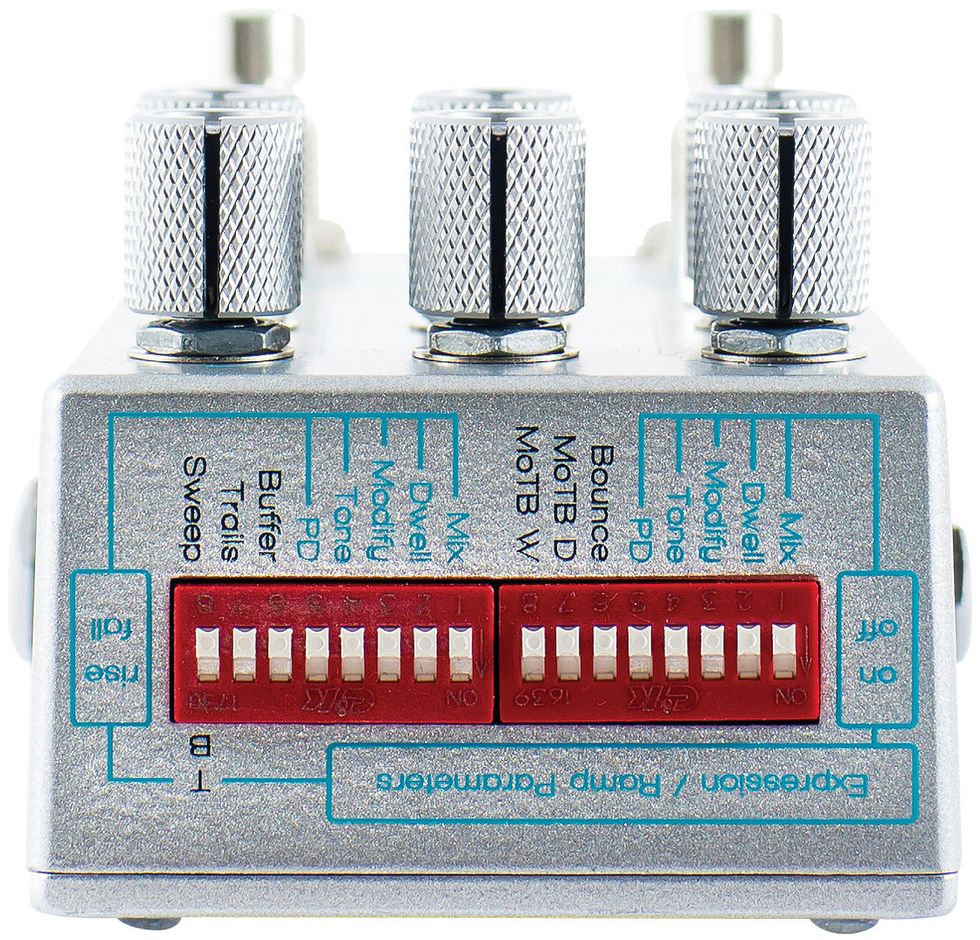RatingsPros:Unique reverb effects. Countless combinations. Expressive real-time control. Flexible routing. Stores two settings. Cons: Not cheap. Mono only. Street: $349 Chase Bliss Dark World chaseblissaudio.com | Tones: Ease of Use: Build/Design: Value: |
You can describe the concept behind most Chase Bliss effects in four words: “analog effects, digital control.” Designer Joel Korte’s pedals can perform such digital tricks as preset storage, real-time control, and exquisitely complex parameter adjustments—without compromising their warts-and-all analog color.
But the Dark World is a departure for Chase Bliss. It’s their first all-digital device. So is it devoid of weird sonic warts?
Uh … no.
Double Digital
The Dark World pairs two reverb circuits in a single 125B-sized enclosure. It’s a collaboration between Korte and two other pedal makers. One circuit (“World”) is a straightforward hall/ plate/spring simulator by Robert Keeley. The other (“Dark”) is freakier, based in part on low-fi designs from Cooper FX. The implementation (including MIDI control, expression-in jack, a trio of 3-way toggle switches, and a bank of 16 tiny DIP switches on the side-top surface) mirrors previous Chase Bliss products. There’s a dedicated on/off switch for each reverb, a blend knob to balance their levels, and a global tone control to nudge those blends brighter or darker.
Each reverb employs its own Spin FV-1 DSP chip, but man, do the results differ! The sweet-toned World reverb offers relatively conventional colors. Typically for FV-1 reverb, the results don’t sound identical to their analog inspirations, but they’re more than listenable. Long reverb tails are nice and smooth, with little lo-res granularity. A pair of knobs specifies the reverb and pre-delay times.
The Dark Side
The Dark reverb is … something else entirely. It’s a spinoff from Cooper FX’s Generation Loss pedal, which calls itself a “lo-fi VHS simulator.” It’s actually digital reverb with artfully applied modulation, bit-crushing, and sample reduction. These effects introduce wobbly pitch shifts, treble loss, and seemingly random clicks and pops. All are regulated by a single “modify” knob. Crank it clockwise, and degradation ensues.
And what lovely degradation it is! These tones are fragile and dreamlike, evoking distant radio broadcasts, faded photos, and, yup, rotting VHS tapes. If you can perceive beauty in decay, you’ll encounter it in these sad, lonely sounds. (Note to self: Check out the Cooper FX Generation Loss pedal. Updated note to self: Dang—it’s discontinued.)
Infinite Ambience
Now, imagine running those distressed tones through rich conventional reverb. Or running conventional reverb through the Dark’s filtering, modulation, and distortion. Or combining both effects in parallel rather than in series. (There’s a 3-way routing toggle that enables these modes.) You can also use each reverb on its own. Are you getting a sense of the possibilities here? And we’ve only covered about half the options.
That degraded “VHS” tone is merely one of the Dark’s three modes. And the rest each add unique twists to the otherwise common functions they perform. The shimmer, for instance, transposes the wet signal up or down an octave. But instead of performing a straightforward transposition, the shimmer is created by a complex and shifting dual-channel algorithm. There’s also a freeze mode for infinite sustain. But rather than just capture and hold a snippet of audio, it clears the reverb buffer and captures new chunks of incoming audio depending on whether you play loud enough to trigger an adjustable volume threshold. These refinements lend extra animation to these ordinarily static effects. And they’re not the only source of animation: the Dark World has many real-time control options.

Chips and DIPs
With a connected expression controller (not included), you can pilot the Dark World’s primary parameters in real time. The DIP switches select which of the five parameters the pedal controls and sets their polarity. The possible combinations aren’t literally infinite, but it can feel that way.
All this makes for a spellbinding playing experience, especially when using an expression controller. It’s difficult not to stumble upon exciting new sounds within a few minutes. And you can save two favorites in memory, recallable via footswitch.
Whatever the settings, the Dark World favors a particular type of playing: dreamy clean-toned parts with lots of empty space. Sure, you could play distorted riffs or speedy lines. But the reverbs are so compelling that you’ll probably find yourself playing a note or two and then pausing to hear what happens. That’s the approach I take in the audio clip, as does every online demo I encountered.
The Verdict
The Dark World’s seemingly endless reverb textures are bewitching. There are many fresh sounds here, and they get even more exciting with expression control. If you like spacy ambient textures, you’ll be in ecstasy. The $349 price may seem high, but remember that the Dark World provides two complete reverb effects and many ways to combine them. It fuses ideas from three different manufacturers. It’s a unique design that required substantial R&D. I call it a good deal—and a great stompbox.












![Rig Rundown: John 5 [2026]](https://www.premierguitar.com/media-library/youtube.jpg?id=62681883&width=1245&height=700&quality=70&coordinates=0%2C45%2C0%2C45)





![Rig Rundown: Russian Circles’ Mike Sullivan [2025]](https://www.premierguitar.com/media-library/youtube.jpg?id=62303631&width=1245&height=700&quality=70&coordinates=0%2C0%2C0%2C0)








